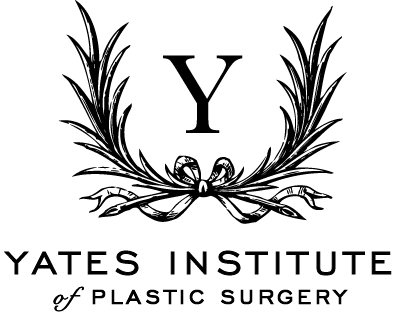
Breast Reconstruction
A Guide to Reconstructive Breast Surgery with Dr. Yates
What is Breast Reconstruction?
Reconstruction of the breast involves recreating the breast form following its removal for cancer. Although the reconstruction will not function just like a normal breast, restoration of the breast form and recreation of symmetry has many immeasurable psychological and quality-of-life benefits. Breast reconstruction helps to restore a woman’s sense of body image after facing breast cancer treatment, and can also enhance self- esteem and self-confidence, a sense of femininity and being complete as a woman.
While facing breast cancer and all the potential treatment that accompanies it can be overwhelming, Dr. Yates aims to help make the breast reconstruction journey as positive as possible for her patients!
The goal of breast reconstruction is to recreate the breast form following removal, considering Aesthetics (beauty), Symmetry (matching the breasts to one another), Longevity (creating a long-lasting result), with Minimal “Morbidity” (without giving up function, which means without sacrificing major muscles of the body). Being a women herself, Dr. Yates is extremely sensitive to the aesthetic considerations of the reconstructed breast.
In our practice, we offer all types of breast reconstruction, including implant-based reconstruction in a single stage, Microsurgical free flap reconstructions and local tissue rearrangements after lumpectomy (breast reconstruction via reduction or breast lift). Our goal is to create a beautiful and well-proportioned breast reconstruction for each woman undergoing cancer treatment, both while in clothing and when nude. Breast Reconstruction Options: Breast reconstruction techniques are as widely varied as women are. Some procedures make use of prosthetic materials (breast implants), other procedures make use of the body’s own tissue, and some procedures use a combination of both. Breast reconstruction can be classified into two major categories based on the timing of surgery (immediate or delayed) and on the material used to reconstruct the breast (an implant or the body’s own tissue).
These procedures involve the use of breast implants, your own tissue, or a combination of both. Dr. Yates works with patients undergoing both immediate (at the time of surgery) and delayed (a period of time after the breast was removed) reconstruction. She offers tissue expanders, implants, and free flap reconstructions. Dr. Yates will work with you to determine the right reconstruction method to meet your goals. She also performs complex revision procedures and uses ADM (acellular dermal matrix) and fat grafting to optimize previously reconstructed breasts. Dr. Yates strives for an excellent aesthetic outcome when reconstructing the breast, and she commonly cares for patients who have or are undergoing radiation therapy.
What is Immediate Breast Reconstruction?
Immediate breast reconstruction refers to a single surgery in which both the mastectomy and the reconstruction are performed at the same time. Immediate reconstruction preserves all of the breast skin in addition to the nipple and areola in many cases (“nipple-sparing mastectomy”), maintaining the natural shape and contour of the breast.
Advantages of immediate reconstruction include having just one major surgery with one general anesthetic, a single recovery period and avoiding the “loss” experienced by women who do not have immediate reconstruction. Immediate breast reconstruction creates the most natural cosmetic results possible in breast reconstruction. Many women’s breasts look just the way they did prior to surgery, and others look even better after reconstruction than before!
What is Delayed Breast Reconstruction?
Delayed breast reconstruction indicates a period of time has occurred between the mastectomy and reconstruction. Delayed reconstruction is possible any time after cancer treatment is complete. There are neither age limits nor a finite length of time after mastectomy (or lumpectomy) when reconstruction would not be considered.
In delayed reconstructions, as opposed to immediate surgery, missing breast skin usually must be expanded by an implant or replaced using a flap. Additional scars may be visible when compared to immediate reconstruction (where the breast skin and often the nipple is preserved), and a secondary procedure will be required to reconstruct a nipple and areola (as opposed to nipple-sparing procedures).
How does Chemotherapy Affect my Breast Reconstruction?
If “neoadjuvant” chemotherapy (given before the mastectomy to help shrink the tumor) is needed, mastectomy or lumpectomy is usually scheduled 6 weeks after “chemo” is over to allow the body and the immune system to recover as much as possible before surgery. However, a breast reconstruction consultation can occur at any time during a woman’s cancer journey so that she may become fully educated about her options for breast reconstruction and to plan for the future. Chemotherapy before reconstruction slightly increases the risk of wound healing difficulties, overall fatigue after surgery and increases the risk of infection. It is important that you maintain the best possible nutrition and take care of your body during this time!
Postoperative chemotherapy (after mastectomy or lumpectomy and reconstruction) usually does not start for at least six weeks after surgery, or when your healing is complete and your incisions are maturing. Implant inflation will be complete by this time, and you will be well on the way to healing after an implant reconstruction or a flap. The implant port is often kept in place during postoperative chemotherapy to enable additional changes in implant volume if desired.
How does radiation affect my breast reconstruction?
If you have had radiation prior to breast reconstruction or if you are currently undergoing radiation therapy, At least 3-6 months must pass after the completion of your radiation before reconstruction can occur. It takes at least 3 months, occasionally up to a year for the initial swelling (“edema”) of radiation to settle. After the initial phase of radiation fades (redness, swelling, warmth, tingling and occasionally blisters), you may develop chronic, permanent changes to your skin (slightly darkened skin color, firmer texture to the skin). Radiation effects are permanent and considerably influence your reconstructive options.
If you are planning your cancer treatment and have a high chance of needing radiation therapy, we usually request that implant reconstructions be done before radiation is given. This will enable full inflation of the implant, creation of a natural breast shape and often implant exchange and/or nipple-areolar reconstruction before radiation. Wound healing will occur under the best possible circumstances if radiation can be delayed until after reconstruction is complete.
If you have already had a mastectomy and radiation therapy with a flat contour to your chest (no skin excess), then a Flap is usually recommended. Placing an implant beneath stiff and contracted radiated chest skin has an increased risk of complications such as infection, thinning of the skin, implant exposure, “extrusion” (coming through the skin), and the consequent need for implant removal. A flap helps to counteract radiation- related damage by bringing new, healthy, living tissue with a robust blood supply to the area of radiation.
If I have breast reconstruction on one side, what happens with the other side?
A balancing procedure is usually recommended for your opposite breast to match the reconstructed breast. Balancing procedures is based on the details of your reconstruction. Surgery on the non-cancer breast is also covered by insurance and can be done at the time of initial reconstruction or later (with nipple reconstruction or port removal).
Is breast reconstruction covered by my insurance?
By law, a woman has the right to a mastectomy or a lumpectomy if she chooses and to have the breast reconstruction option of her choice. Likewise, if a “balancing procedure” to the other breast is recommended by your surgeon (such as a lift, reduction or a breast augmentation) in order to best match the reconstructed breast, this is also covered by insurance.
Occasionally, women wish to have a prophylactic mastectomy on the non-cancer side and have both of their breasts reconstructed at the same time. We encourage our patients to speak to their Oncology team about their individual risk and to receive additional guidance about having a second mastectomy with reconstruction.
If you have previously had reconstruction but wish to have an improvement of your results, you are still a candidate for Revision Breast Surgery in order to make your reconstruction more symmetric, balanced, or beautiful.
Your personal financial responsibility for surgery depends on the specifics of your insurance plan and whether your surgeon is a participating provider for your particular plan. Our Patient Coordinator will go over this with you in detail as we plan your surgery and will assist you in using your insurance to your greatest advantage.
How does Dr. Yates decide which method of Reconstruction is best for me?
When first meeting a woman in consultation for breast reconstruction, we ask her: “If we could just wave a magic wand (how nice would that be!), how would you WISH your breasts to be? Larger, smaller, fuller, perkier, or just the same as you are now?” Breast reconstruction should be viewed as an opportunity, and we aim to make the reconstructive process a rewarding and positive experience for each of our patients facing breast cancer. As one patient put it, “Let’s make lemonade out of lemons!”
We encourage you to do some “soul searching”, and consider yourself a strong, empowered breast cancer survivor who deserves to look and feel beautiful, healthy and proud of her breasts! Evaluate what your personal goals are for breast reconstruction. Make a wish list and jot down questions to bring with you to your consultation and preoperative visit so that we can best answer your questions, address your concerns and together determine which procedure(s) will best achieve your goals.
Nipple Tattoos
A nipple tattoo is a realistic, 3D image of the nipple-areola complex for women who have undergone a mastectomy procedure. Nipple tattoos may be used to create a new nipple areola complex or enhance an existing nipple tattoo that has faded over time. This procedure is often covered by your health insurance provider as a stage in your reconstructive journey. Please be advised that nipple tattoos do require prior authorization.
Duration: 1 to 2 hrs; 30mins – 1hr/breast
Downtime: None

